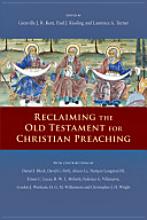 Reclaiming the Old Testament for Christian Preaching
Reclaiming the Old Testament for Christian Preaching
I’ve been pleasantly surprised by this book. The result of a 2009 Academic Study Conference in Cambridge, I wasn’t expecting too much, to be honest; but it’s far exceeded my expectations. Most of the writers have made a really good attempt at making their writing accessible and practical for preachers. I’ve just noticed that it also won the 2011 Preaching Today Magazine book award.
I’m going to post some summaries and comments on the best chapters over the next few weeks, which hopefully will motivate you to buy, read, and use.
The first chapter is by Lawrence Turner and covers the popular topic of preaching Old Testament narrative, with a specific focus on plot.
Avoid these two errors
1. Retelling the biblical account blow by blow and then appending a general moral obligation
2. Picking one point from the narrative and impaling it on the frame of Aristotelian logic
Don’t be averse to literary “criticism” (fancy word for scholarly studies)
1. Just because liberals have focused on narrative studies, doesn’t mean evangelicals should avoid them
2. Understanding the dynamics of narrative leads to theological and spiritual gains
A classic plot has a fivefold structure
1. Initial situation
2. Complication
3. Transforming action
4. Dénouement (or resolution)
5. Final situation
Look for how narratives vary
1. Consider what the narrator omits or includes
2. There can be any number of transforming actions before resolution and final situation
3. Resolutions can be full, partial, or open-ended
4. The difference between narrative time (how long a period the events take) and narration time (how much Scripture is devoted to the events) tells us what to focus on
Always connect the micro-narratives with the macro-narrative
1. How does this narrative relate to the rest of the book?
2. How does this narrative relate to redemptive history?
Use different ways to present narratives in sermons
1. Try to avoid imposing three-point sermons on narratives (I’ll come back to this)
2. Follow the five-part narrative structure (see above)
3. If following the five-part structure, connect each element of the plot with the world of the congregation (e.g move from the initial situation of the plot to the situation of the congregation, etc), resulting in two stories presented in parallel
4. Preach in the first person adopting the persona of one of the characters (please don’t do this!)
5. Identify the “big idea” in the resolution and relate it to the other parts of the plot
6. Individual micro-narratives should be preached as part of a macro-narrative series, resulting sometimes in unresolved plots in some sermons (which are also closer to reality)
Connect the plot to the overarching plot of the Bible
1. The whole message of the Bible matches the five-part narrative plot structure
2. OT narratives lead to the NT, are often resolved by the NT, and shed light on the NT
3. OT narratives should not ignore NT reflections on the OT story
4. To make a narrative sermon live, you need an understanding of other narrative elements (e.g. character – in the next chapter) and biblical theology
Comments
This chapter provides lots of practical help for preachers wanting to become better at communicating OT narratives. If I pick up one good tip from a book on preaching, I’m usually quite content. However, this one chapter alone has given me three or four things to try out in my preaching.
I agree with Lawrence, that we have much to gain from literary studies. Richard Pratt, Leland Ryken, and David Dorsey’s work in this area have greatly enhanced my appreciation for the literary characteristics of OT narrative. However, it can all get a bit over-complicated at times and the insights are often difficult to convey in a sermon, unless the congregation have some handout to follow along with.
While I understand Lawrence’s criticism of “story+moral” and “three points” approaches, he is over harsh on these older methods of preaching narratives. Although they have often been done badly, there are many excellent examples of such preaching styles in the past and the present. While we welcome new insights to freshen up our preaching, surely we don’t want to throw out all the old methods. One of the problems with the newer narrative-style approach to preaching narratives is that while it’s quite compelling at the time, it’s often difficult to remember a day or two after. Structure is so important to understanding and retention.
The fivefold structure insight is extremely helpful in working our way through the exegesis of a plot, but it shouldn’t become the regular structure of our sermons. We just become so predictable again.
I liked Lawrence’s idea of connecting the micro-narrative with the bigger OT and NT story line. But I also liked his idea that if the particular plot we are working on that week does not result in a total resolution, sometimes we should just leave it that way, because that’s what life is so often like. It’s more like people’s experience.
I would strongly advise to avoid the first-person persona idea. I know it’s novel and trendy, but as far as I can see it’s not a pattern we find in Scripture. It results in too much focus on the preacher, and virtually turns him from a herald into an actor.
I’d give the chapter 8 or 9 out of 10. A good start!